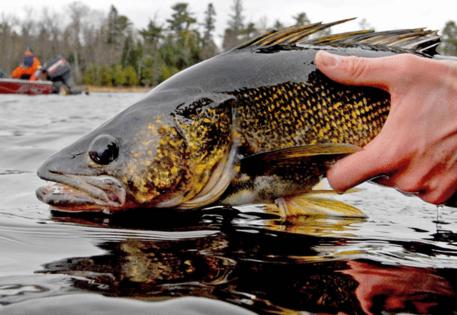Dennis Anderson: DNR wants to cut Minnesota walleye limit to four, but some want the idea thrown back
Published in Outdoors
MINNEAPOLIS — Only if President Donald Trump and Gov. Tim Walz squared off over a Department of Natural Resources plan to lower Minnesota’s walleye limit could the proposal be more controversial than it already is.
But even those political rivals couldn’t add more sparks to a fisheries management proposition that already is sizzling among walleye anglers — and the season hasn’t even opened yet.
The leader of one side of the squabble is Brad Parsons, DNR fisheries section chief. He concedes that while no scientific justification exits to reduce the walleye limit from six to four on all Minnesota lakes, it’s better to manage walleye harvests conservatively given that climate change, new fishing technologies, social media and evermore efficient anglers will pose broad-scale challenges to walleye fishing in coming years.
In fact, those challenges are already here, Parsons said.
“The DNR is often accused of being reactive rather than proactive,” he said. “In this case, we’re being proactive.”
Not so fast, say some retired DNR fisheries biologists and managers.
“Lowering the walleye bag limit isn’t going to do any good for walleyes or walleye fishing, and will only make some fishermen feel better about a problem we don’t have,” said Gary Barnard, a 43-year DNR employee and retired area fisheries manager stationed in Bemidji. “The DNR has one of the most extensive walleye databases in the world, and there’s nothing in it that suggests we’re over-harvesting walleyes.”
Talked about for years, and proposed (and defeated) in the Legislature in 2022, the lower-limit walleye plan will be announced as a DNR rule-making proposal in May. A 60-day public comment period will follow.
The soonest the lower limit could be effective is March of next year.
“We’ll take the comments we receive seriously,” Parsons said. “I’ve talked to a number of people about it already. Some resort owners have asked if we can keep the walleye possession limit at six, but the daily limit at four [with one over 20 inches]. Others say we should go to three walleyes, not four. It’s possible after we get feedback that we will modify our proposal. But right now, four walleyes statewide is our plan.”
Fisheries managers who object to the lower limit say it won’t improve walleye fishing because very few anglers catch more than one or two walleyes an outing. More importantly, they claim it would remove management options needed to regulate walleyes on a lake-by-lake basis, while unnecessarily burdening fisheries managers — and anglers — with lower limits that won’t help walleye populations.
In some lakes, they say, higher walleye harvest limits of certain sizes are periodically needed to spur recruitment of young fish into a population. That’s what’s happening on Upper Red Lake this year, where the DNR increased the walleye limit to five starting with the May 10 opener, with one walleye allowed longer than 17 inches.
Last summer’s Upper Red walleye limit was three until June 15, when it changed to four, with one walleye over 17 inches allowed in each period.
“For 20 years we’ve been managing Upper Red to maintain its spawning stock within certain parameters,” said Henry Drewes, who retired in 2021 as DNR Northwest Region fisheries manager. “This year’s five-walleye bag limit matches that management objective. It’s fitting the regulation to the specific lake, which is important.”
The DNR annually gathers detailed walleye population data on the state’s biggest walleye-producing lakes. But accumulating specific information on all of Minnesota’s 1,600 or so walleye waters isn’t possible, Parsons said, making tailored walleye management — and harvest levels — on all state lakes problematic.
“Where we have our best science is on our larger walleye lakes,” he said. “And most of those are already at four-walleye limits.”
Most ... but not all.
Consider Winnibigoshish (“Winnie”), a 67,000-acre watery walleye haven that again this summer will be governed by a six-walleye limit with an 18-23 inch protected slot and one walleye allowed over 23 inches.
Winnie’s walleye limit exceeds those of Vermilion and Lake of the Woods and some of the state’s other big walleye producing lakes because the higher-harvest regulation best serves Winnie’s walleyes, while also benefiting anglers and area resort owners and other businesses.
If a new statewide four-walleye limit is enacted, Winnie’s walleye limit would be cut, Parsons acknowledged, even if that action won’t necessarily benefit the lake’s fishery.
What’s more, revising upward Winnie’s — or another lake’s — walleye limit once it’s governed by a statewide four-walleye restriction would be difficult, because such changes must be done through rule making, a time-consuming process. Annual harvest adjustments on Upper Red and Mille Lacs lakes, by contrast, can be made by “commissioner’s orders,” because they’re governed by treaty arrangements.
“Part of the [rule making] process is that if a relatively small number of people object to the proposed rule, the issue has to go before an administrative law judge for a decision,” Parsons said. ”I expect people will object to our proposal to reduce the statewide walleye limit, and we will have to explain our position to a judge who ultimately will give an opinion."
Parsons conceded that some current DNR fisheries managers disagree with the limit reduction proposal. “But most support it,” he said.
The majority of the state’s Walleye Advisory Council, which offers feedback to the DNR, also supports the cutback, member Jim Justesen said. And a majority of attendees at a recent fisheries summit sponsored by the conservation group MN-FISH backed the idea.
Tom Neustrom, of Grand Rapids, is among fishing guides who believe lowering the walleye limit will help protect the fishery.
“People talk about the science of walleye management, but what about common sense?” Neustrom said. “The last time Minnesota had a walleye limit change was in 1956. With the new electronics that people have, you tell me what’s going to happen to walleyes in the next 15 or 20 years if we don’t do something. This isn’t about one person or one group. It’s about Minnesota and its fish.”
____
©2025 The Minnesota Star Tribune. Visit startribune.com. Distributed by Tribune Content Agency, LLC







Comments